- Home
- Franz Kafka
The Complete Stories
The Complete Stories Read online
The Complete Stories
Franz Kafka
Copyright © 1971 by Schocken Books Inc.
All rights reserved under International and Pan-American Copyright Conventions.
Published in the United States by Schocken Books Inc., New York.
Distributed by Pantheon Books, a division of Random House, Inc., New York.
The foreword by John Updike was originally published in The New Yorker.
Foreword copyright © 1983 by John Updike.
Collection first published in 1971 by Schocken Books Inc.
Library of Congress Cataloging-in-Publication Data
Kafka, Franz, 1883-1924.
The complete stories.
(Kafka Library)
Bibliography: p.
1. Kafka, Franz, 1885-1924 — Translations, English.
I. Glatzer, Nahum Norbet, 1903- . I. Title.
ü. Series.
PT2621.A26A2 1988 833'.912 88-18418
ISBN 0-8052-0873-9
Manufactured in the United States of America
3 5 7 9 8 6 4 2
Contents
Copyright
Foreword by John Updike
TWO INTRODUCTORY PARABLES
Before the Law*
An Imperial Message*
THE LONGER STORIES
Description of a Struggle
Wedding Preparations in the Country
The Judgment*
The Metamorphosis*
In the Penal Colony*
The Village Schoolmaster [The Giant Mole]
Blumfeld, an Elderly Bachelor
The Warden of the Tomb
A Country Doctor*
The Hunter Gracchus
The Hunter Gracchus: A Fragment
The Great Wall of China
The News of the Building of the Wall: A Fragment
A Report to an Academy*
A Report to an Academy: Two Fragments
The Refusal
A Hunger Artist*
Investigations of a Dog
A Little Woman*
The Burrow
Josephine the Singer, or the Mouse Folk*
THE SHORTER STORIES
Children on a Country Road*
The Trees*
Clothes*
Excursion into the Mountains*
Rejection*
The Street Window*
The Tradesman*
Absent-minded Window-gazing*
The Way Home*
Passers-by*
On the Tram*
Reflections for Gentlemen-Jockeys*
The Wish to Be a Red Indian*
Unhappiness*
Bachelor's Ill Luck*
Unmasking a Confidence Trickster*
Sudden Walk*
Resolutions*
Dream*
Up in the Gallery*
A Fratricide*
The Next Village*
A Visit to a Mine*
Jackals and Arabs*
The Bridge
The Bucket Rider
The New Advocate*
An Old Manuscript*
The Knock at the Manor Gate
Eleven Sons*
My Neighbor
A Crossbreed [A Sport]
The Cares of a Family Man*
A Common Confusion
The Truth About Sancho Panza
The Silence of the Sirens
Prometheus
The City Coat of Arms
Poseidon
Fellowship
At Night
The Problem of Our Laws
The Conscription of Troops
The Test
The Vulture
The Helmsman
The Top
A Little Fable
Home-Coming
First Sorrow*
The Departure
Advocates
The Married Couple
Give it Up!
On Parables
Postscript
Bibliography
Editors and Translators
On the Material
Chronology
Selected Writings on Kafka
Back Cover
* Published during Kafka's lifetime.
FOREWORD
By John Updike
All that he does seems to him, it is true, extraordinarily new, but also, because of the incredible spate of new things, extraordinarily amateurish, indeed scarcely tolerable, incapable of becoming history, breaking short the chain of the generations, cutting off for the first time at its most profound source the music of the world, which before him could at least be divined. Sometimes in his arrogance he has more anxiety for the world than for himself.
— KAFKA, "He" (Aphorisms)
THE century since Franz Kafka was born has been marked by the idea of "modernism" — a self-consciousness new among centuries, a consciousness of being new. Sixty years after his death, Kafka epitomizes one aspect of this modern mind-set: a sensation of anxiety and shame whose center cannot be located and therefore cannot be placated; a sense of an infinite difficulty within things, impeding every step; a sensitivity acute beyond usefulness, as if the nervous system, flayed of its old hide of social usage and religious belief, must record every touch as pain. In Kafka's peculiar and highly original case this dreadful quality is mixed with immense tenderness, oddly good humor, and a certain severe and reassuring formality. The combination makes him an artist; but rarely can an artist have struggled against greater inner resistance and more sincere diffidence as to the worth of his art.
This volume holds all of the fiction that Kafka committed to publication during his lifetime:* a slender sheaf of mostly very short stories, the longest of them, "The Metamorphosis," a mere fifty pages long, and only a handful of the others as much as five thousand words. He published six slim volumes, four of them single stories, from 1913 to 1919, and was working on the proofs of a seventh in the sanatorium where he died on June 3rd, 1924, of tuberculosis, exactly one month short of his forty-first birthday. Among his papers after his death were found several notes addressed to his closest friend, Max Brod. One of them stated:
Of all my writings the only books that can stand are these: The Judgment, The Stoker, Metamorphosis, Penal Colony, Country Doctor and the short story: Hunger-Artist. . . When I say that those five books and the short story can stand, I do not mean that I wish them to be reprinted and handed down to posterity. On the contrary, should they disappear altogether that would please me best. Only, since they do exist, I do not wish to hinder anyone who may want to, from keeping them.
* The single exception is "The Stoker," published as Der Heizer, Ein Fragment in 1913 but now incorporated, in German and in English, as the first chapter of Kafka's unfinished novel Amerika.
The little canon that Kafka reluctantly granted posterity would, indeed, stand; "The Metamorphosis" alone would assure him a place in world literature, though undoubtedly a less prominent place than he enjoys thanks to the mass of his posthumously published novels, tales, parables, aphorisms, and letters. The letter quoted above went on to direct Brod to burn all of Kafka's manuscripts, "without exception and preferably unread." Another note, written later, reiterated the command even more emphatically; and Dora Dymant, the young woman with whom Kafka shared the last year of his life, obediently did destroy those portions of the Kafka hoard within her keeping. But Brod disobeyed. Predictably: while Kafka was alive Brod had often elicited manuscripts from his excessively scrupulous friend and was instrumental in the publication of some few of them. In Brod's words: "he knew with what fanatical veneration I listened to his every word. . . during the whole twenty-two years of our unclouded friendship, I never once threw away the smallest scrap of paper that came from
him, no, not even a post card." In a conversation of 1921 he warned Kafka he would burn nothing. And so with good conscience the reverent executor issued to the world The Trial and The Castle -- both novels unfinished and somewhat problematical in their texts but nevertheless magnificently realized — and a host of lesser but still priceless fragments, painstakingly deciphered and edited. Kafka and Shakespeare have this in common: their reputations rest principally on texts they never approved or proofread.
This volume, then, holds as well many stories in various states of incompletion. Some, like "The Village Schoolmaster" and "Blumfeld, an Elderly Bachelor," seem fatally truncated, their full intentions and final design destined to remain mysterious. In some others, notably "Investigations of a Dog," the author seems to have played out his inspiration without rounding out the story; Kafka's need to explore this conceit of philosophical speculation in a canine world where human beings are somehow unseen ("a sort of canine atheism" one commentator has called the phenomenon) has been happily exhausted before an end is reached. The failure is purely mechanical and we do not feel cheated, since the story's burden of private meaning has been unloaded — there are scarcely any pages in Kafka more sweetly and winningly autobiographical than these. In still other of these uncompleted stories, such as "The Great Wall of China" and "The Burrow," the end is even nearer, and we do not wish for any more. According to Dora Dymant, "The Burrow" had been concluded, in a version she destroyed, with a "scene describing the hero taking up a tense fighting position in expectation of the beast, and the decisive struggle in which the hero succumbs"; though there is poignance in this — "the beast" was Kafka's nickname for his disease, to which he was to succumb within a few months — we are glad to leave the burrowing hero, fussily timorous and blithely carnivorous, where he is, apprehensively poised amid menaces more cosmic and comic than anything his claws could grapple with. "The Burrow" and "The Great Wall of China" belong at the summit of Kafka's oeuvre; their fantastic images are developed with supreme elegance and resonance. The German titles of both contain the word "Bau." Kafka was obsessed with building, with work that is never done, that can never be done, that must always fall short of perfection. His manuscripts show Kafka to have been a fervent worker, "scribbling" (as he called his writing) with a stately steadiness across the page, revising rather little, but ceasing when authenticity no longer seemed to be present, often laying down parallel or even contradictory tracks in search of his prey, and content to leave his works in an "open" state like that of his Great Wall — their segments uncertainly linked, strange gaps left, the ultimate objective shied from as if too blindingly grand. Not to write for money or the coarser forms of glory is common enough among modern avant-gardists; but to abjure aesthetic "finish" itself carries asceticism a step farther, into a realm of protest where such disparate modernists as Eliot and Pound (in the intrinsically fragmentary nature of their poetry) and Rilke and Salinger (in their capacities for silence) keep Kafka company. Incompletion is a quality of his work, a facet of its nobility. His briefest paragraphs and riddles sufficiently possess the adamancy of art.
Hearing Kafka read aloud from his youthful works "Description of a Struggle" and "Wedding Preparations in the Country" instantly convinced Max Brod that his friend was a genius: "I got the impression immediately that here was no ordinary talent speaking, but a genius." You who are picking up this volume in innocence of the author, however, might do well to skip these first two titles and return to them when initiated. Repeated readings of these grouped fragments have left them, for me, not merely opaque but repellent. "Description" was composed no later than 1904-5, when Kafka was in his early twenties. It is full of contortions both psychological ("I had to restrain myself from putting my arm around his shoulders and kissing him on the eyes as a reward for having absolutely no use for me") and physical ("this thought. . . tormented me so much that while walking I bent my back until my hands reached my knees"; "I screwed up my mouth. . . and supported myself by standing on my right leg while resting the left one on its toes"). There is something of adolescent posturing here, or of those rigid bodily states attendent upon epilepsy and demonic possession. The conversation seems hectic, and the hero and his companions pass a mysterious leg injury back and forth like the ancient Graeae sharing one eye. Self-loathing and self-distrust lurk within all this somatic unease; the "supplicant" prays in church at the top of his voice "in order to be looked at and acquire a body." A certain erotic undercurrent is present also, and in "Wedding Preparations" the hero, Eduard Raban, is proceeding toward his wedding in the country. This narrative at least boasts a discernible direction; but we strongly feel that Raban, for all his dutiful determination, will never get there. The typical Kafkaesque process of non-arrival is underway. And in truth Kafka, though heterosexual, charming, and several times engaged, and furthermore professing that "Marrying, founding a family, accepting all the children that come [is] the utmost a human being can succeed in doing at all," never did manage to get married.
The charm that these disquieting, abortive early pieces exerted upon Brod and other auditors (for Kafka used to read his work aloud to friends, sometimes laughing so hard he could not continue reading) must have largely derived from the quality of their German prose. These lucid and fluent translations by the Muirs and the Sterns can capture only a shadow of what seems to have been a stirring purity. "Writing is a form of prayer," Kafka wrote in his diary. Thomas Mann paid tribute to Kafka's "conscientious, curiously explicit, objective, clear, and correct style, [with] its precise, almost official conservatism." Brod likened it to J. P. Hebel's and Kleist's, and claimed that "its unique charm is heightened by the presence of Prague and generally speaking Austrian elements in the run of the sentence." The Jews of Prague generally spoke German, and thus was added to their racial and religious minority-status a certain linguistic isolation as well, for Czech was the language of the countryside and of Bohemian nationalism. It is interesting that of the last two women in Kafka's life — two who abetted the "reaching out" of his later, happier years — Milena Jesenská-Pollak was his Czech translator and helped teach him Czech, and Dora Dymant confirmed him in his exploratory Judaism including the study of Hebrew. He wrote to Brod of the problems of German: "Only the dialects are really alive, and except for them, only the most individual High German, while all the rest, the linguistic middle ground, is nothing but embers which can only be brought to a semblance of life when excessively lively Jewish hands rummage through them." Though fascinated by the liveliness of Yiddish theatre, he opted for what Philip Rahv has called an "ironically conservative" style; what else, indeed, could hold together such leaps of symbolism, such a trembling abundance of feeling and dread?
Kafka dated his own maturity as a writer from the long night of September 22nd-23rd, 1912, in which he wrote "The Judgment" at a single eight-hour sitting. He confided to his diary that morning, "Only in this way can writing be done, only with such coherence, with such a complete opening out of the body and the soul." Yet the story is not quite free of the undeclared neurotic elements that twist the earlier work; the connection between the engagement and the father seems obscure, and the old man's fury illogical. But in staring at, with his hero Georg, "the bogey conjured up by his father," Kafka broke through to a great cavern of stored emotion. He loved this story, and among friends praised — he who deprecated almost everything from his own pen — its Zweifellosigkeit, its "indubitableness." Soon after its composition, he wrote, in a few weeks, "The Metamorphosis," an indubitable masterpiece. It begins with a fantastic premise, whereas in "The Judgment" events become fantastic. This premise — the gigantic insect — established in the first sentence, "The Metamorphosis" unfolds with a beautiful naturalness and a classic economy. It takes place in three acts: three times the metamorphosed Gregor Samsa ventures out of his room, with tumultuous results. The members of his family — rather simpler than Kafka's own, which had three sisters — dispose themselves around the central horror with a touching, as well a
s an amusing, plausibility. The father's fury, roused in defense of the fragile mother, stems directly from the action and inflicts a psychic wound gruesomely objectified in the rotting apple Gregor carries in his back; the evolutions of the sister, Crete, from shock to distasteful ministration to a certain sulky possessiveness and finally to exasperated indifference are beautifully sketched, with not a stroke too much. The terrible but terribly human tale ends with Crete's own metamorphosis, into a comely young woman. This great story resembles a great story of the nineteenth century, Tolstoy's "The Death of Ivan Ilyich"; in both, a hitherto normal man lies hideously, suddenly stricken in the midst of a family whose irritated, banal daily existence flows around him. The abyss within life is revealed, but also life itself.
What kind of insect is Gregor? Popular belief has him a cockroach, which would be appropriate for a city apartment; and the creature's retiring nature and sleazy dietary preferences would seem to conform. But, as Vladimir Nabokov, who knew his entomology, pointed out in his lectures upon "The Metamorphosis" at Cornell University, Gregor is too broad and convex to be a cockroach. The charwoman calls him a "dung beetle" (Mistkäfer) but, Nabokov said, "it is obvious that the good woman is adding the epithet only to be friendly." Kafka's Eduard Raban of "Wedding Preparations" daydreams, walking along, "As I lie in bed I assume the shape of a big beetle, a stag beetle or a cockchafer, I think." Gregor Samsa, awaking, sees "numerous legs, which were pitifully thin compared to the rest of his bulk." If "numerous" is more than six, he must be a centipede — not an insect at all. From evidence in the story he is brown in color and about as long as the distance between a doorknob and the floor; he is broader than half a door. He has a voice at first, "but with a persistent horrible twittering squeak behind it like an undertone," which disappears as the story progresses. His jaws don't work as ours do but he has eyelids, nostrils, and a neck. He is, in short, impossible to picture except when the author wants to evoke his appearance, to bump the reader up against some astounding, poignant new aspect of Gregor's embodiment. The strange physical discomfort noted in the earlier work is here given its perfect allegorical envelope. A wonderful moment comes when Gregor, having been painfully striving to achieve human postures, drops to his feet:

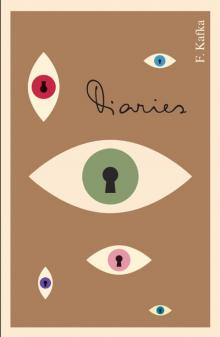 Diaries of Franz Kafka
Diaries of Franz Kafka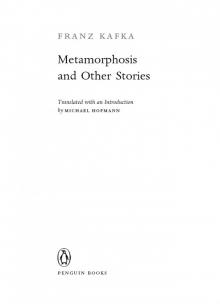 Metamorphosis and Other Stories
Metamorphosis and Other Stories The Castle: A New Translation Based on the Restored Text
The Castle: A New Translation Based on the Restored Text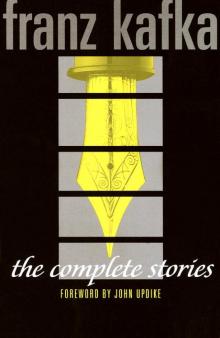 The Complete Stories
The Complete Stories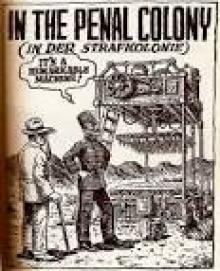 In the Penal Colony
In the Penal Colony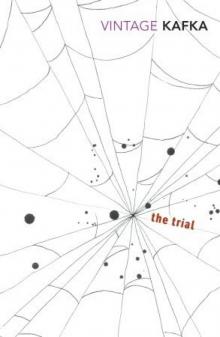 The Trial
The Trial Amerika
Amerika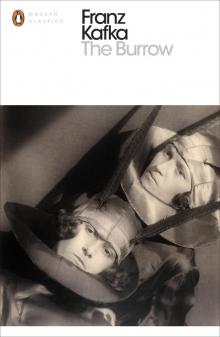 The Burrow: Posthumously Published Short Fiction
The Burrow: Posthumously Published Short Fiction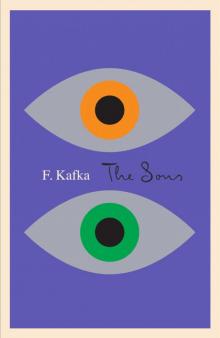 Sons
Sons Letters to Milena
Letters to Milena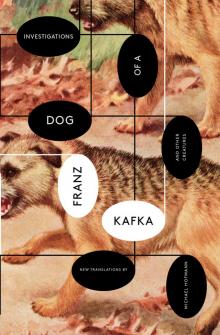 Investigations of a Dog: And Other Creatures
Investigations of a Dog: And Other Creatures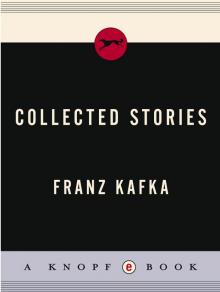 Collected Stories
Collected Stories The Great Wall of China
The Great Wall of China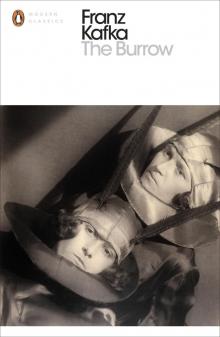 The Burrow
The Burrow The Castle
The Castle The Meowmorphosis
The Meowmorphosis The Sons
The Sons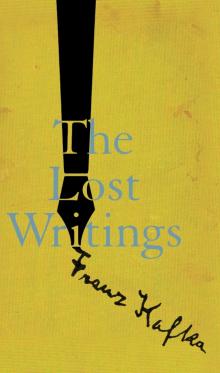 The Lost Writings
The Lost Writings The Unhappiness of Being a Single Man
The Unhappiness of Being a Single Man Amerika: The Missing Person: A New Translation, Based on the Restored Text
Amerika: The Missing Person: A New Translation, Based on the Restored Text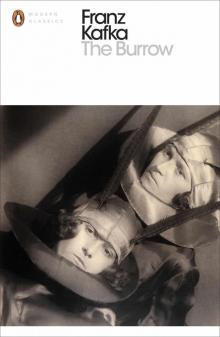 The Burrow: Posthumously Published Short Fiction (Penguin Modern Classics)
The Burrow: Posthumously Published Short Fiction (Penguin Modern Classics)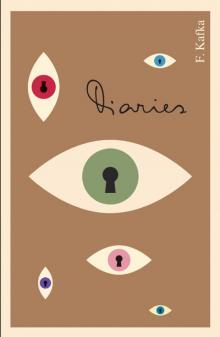 The Diaries of Franz Kafka
The Diaries of Franz Kafka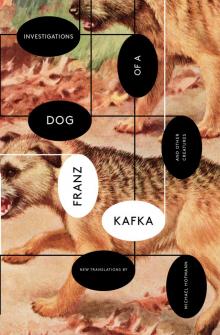 Investigations of a Dog
Investigations of a Dog The Metamorphosis and Other Stories
The Metamorphosis and Other Stories The Trial: A New Translation Based on the Restored Text
The Trial: A New Translation Based on the Restored Text